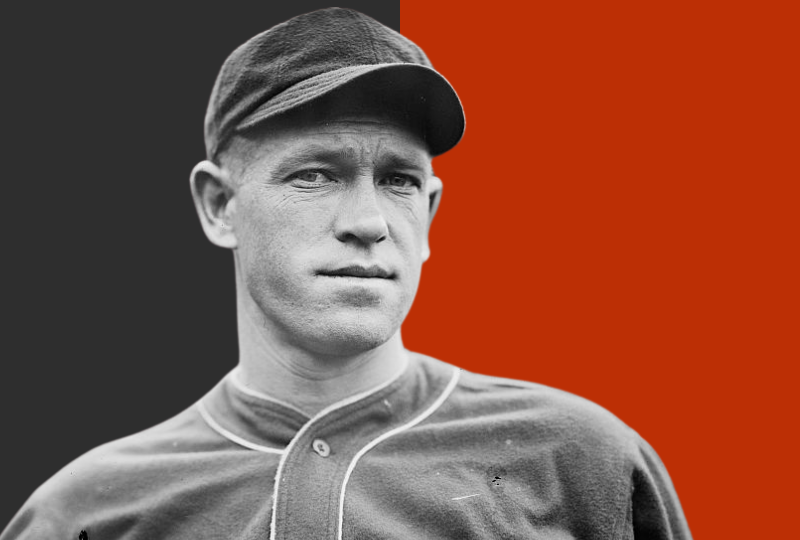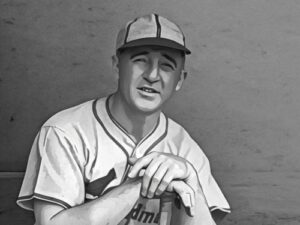The Woody Woodpecker of baseball history, Hal Chase was a master instigator. Beyond that, he was a bad teammate and a criminal who nested himself among gamblers who conspired to throw the World Series, probably more than once. He survived many years in professional baseball because he fluttered about in an era when ethics were rarely demanded among ballplayers. But, eventually his nefarious actions caused his banishment from organized baseball for betting against his own teams.
Hughie Jennings managed the Detroit Tigers for 14 seasons, coinciding with Chase’s checkered career. Jennings, always astute, knew a jackal when he saw one.
“For all [Chase’s] ability, I would not have him on my club,” Jennings said. “He will not heed training rules, and has a demoralizing influence on younger players.”
That quote from Jennings came in March 1916, when much of professional baseball was coming to understand Chase. By then, the first baseman had been run out of several towns and off of numerous big league clubs. But amazingly, Chase latched on with Cincinnati that spring and embarked on a season that saw him win the National League batting title at the age of 33. Had there been an MVP Award at that time, Chase may have won it.
Such was the environment of the 1910s in baseball: standards were built on a foundation of sand. Like the Republican Party of the 21st century, being honest and grounded wasn’t important. All that mattered was perception, profit, and power. As long as Hal Chase could put asses in the seats and bang out base hits, it didn’t matter if he was a crook.
Maybe the world should have known Chase was unusually corrupt by the fact that he was an unusual athletic specimen: the rare right-handed batter who threw left-handed. Even though he was a southpaw, Chase reportedly played some games at second base, shortstop, and third. But he was most renowned as a defensive whiz at first base.
When Chase was lying on his deathbed (literally) in 1947, The Sporting News published a feature story that called him “the greatest defensive first baseman of all-time.” That opinion was often attached to Chase throughout his career, because of the aggressive manner in which he played the position.
Greatest defensive first baseman of the Deadball Era?
There is, of course, no video of Chase playing defense. But, based on testimony from witnesses, he played first base unlike anyone before he came along. He was credited for popularizing the one handed scoop of bunts and ground balls, and he was the first player at the position to use one hand to catch the baseball frequently. He accomplished this because he had expert hand-eye coordination, and he used a glove a smidge larger than his contemporaries. Prior to 1915, most first basemen used both hands when stretching for throws. If you’ve ever attempted to catch a baseball like that, you know that limits the length of your stretch. With his one-handed stretch (which Chase popularized, but didn’t invent), Hal presented a dazzling display of skill at his position.
Cubs’ manager Frank Selee was in California scouting players before the 1904 season when he saw Chase playing for Saint Mary’s College. Selee had a future Hall of Fame first baseman in Frank Chance, but he recommended Chase to Jim Morley, the owner of the Los Angeles Angels. Morley signed Chase to play for his team after talking to Saint Mary’s. But here’s the thing: Chase wasn’t a student at Saint Mary’s, and the man Morley spoke to wasn’t affiliated with the school at all. Chase set the meeting up, paying a friend to pose as an official from the athletic office. The imposter greased Morley for $70, splitting it with Chase. This was probably not the first time Hal used trickery to pad his pockets, nor was it the last.
A talented con man
Those true crime podcasts and streaming series we have all over today? Hal Chase would have been a marvelous subject for one had it existed in the early 20th century. The Californian swindled, conned, and defrauded his way across the map, eventually bouncing among five teams in three different major league teams. He frequently had to split towns on a red-eye train, and often he left behind a string of befuddled victims and unpaid debts.
His star first sparkled in New York, playing for a team that wasn’t even known as the Yankees yet. Chase was a matinee idol, though he wasn’t particularly handsome. He was the sort of man who charmed and wormed his way through life, chewing up people and spitting them out when he had removed the marrow from their bones, and the money from their pockets. In New York, Chase frequented pool halls, where he met unsavory people, the worst of them “made men” belonging to the mafioso. That’s when Chase first started fixing games in the majors. He turned to that “side hustle” whenever he needed cash.
In the early 1900s, if you were a star player, you might be expected to manage the team also. Chase craved the extra salary that came from that double responsibility, and he craved the attention too. When his longtime manager Clark Griffith was fired during the 1908 season, Chase expected to get the nod as his replacement. Instead, shortstop Kid Elberfeld was awarded the job. Hal was furious, and plotted his revenge. Quickly, he split the clubhouse in two, and aligned a block of players against Elberfeld, who was fired at the end of the season. It’s likely that Chase and perhaps some of his teammates, were purposely losing games that season under the Kid.
Undermined his teammates and manager
New York, then known as the Highlanders, didn’t hire Chase to replace Elberfeld. So, Hal undermined the replacement, the upstanding George Stallings. Predictably, Chase turned players against the new manager, and ultimately Stallings forced the front office to choose him or his first baseman. But, Hal had a strong ally in the owners’ box: when he wasn’t busy running the baseball team, Frank Farrell owned one of the most notorious illegal casinos in New York. His limited partner was Big Bill Devery, a police commissioner who was bought and paid for by organized crime. The Yankee owners were just the type of guys who would benefit from a crooked ballplayer. Not surprisingly, ownership elected to fire Stallings, and Chase was named manager. But that was bound to fail, and Chase resigned after one full season, preferring the less stressful job of first baseman, where he once again took to fixing games.
In 1913, new Yankee skipper Frank Chance quickly realized Chase was a cancer on his team. Chance had the intellectual prowess and respect to demand the removal of Chase from the New York ballclub. Farrell finally agreed to trade Chase, sending him to the White Sox. But the next season, Chase broke his contract and jumped to play for Buffalo of the Federal League, a circuit with audacious team owners willing to spend money to lure players from the AL and NL.
The Federal League is considered a third major league for the two seasons of 1914-15, but the level of talent was uneven. Chase was one of the superior players in the circuit: in 1914 he batted .347 in 75 games; and in 1915 he led the league with 17 home runs.
Welcomed back after a dalliance with the Federal League
When the Federal League went out of business after the 1915 season, Chase had to charm his way back into the major leagues. That’s when he signed with the Reds and won that batting title, mentioned above. Cincinnati is also where he met Jimmy Ring, a pitcher from Brooklyn, and a confidant. Soon, Chase was offering Ring money to pitch poorly. This all went on under the nose of manager Christy Mathewson, the former Giant legend. In 1917, Ring ratted on Chase, and in 1918, Mathewson suspended Chase. But the league couldn’t confirm the accusations, and Hal escaped justice, for a while.
Ultimately, greed sunk Hal Chase. He signed with John McGraw’s Giants for the 1919 season, batted .284, and played his typical dependable defense at first base. But in September, McGraw ordered Chase and his crony, third baseman Heinie Zimmerman, to leave the team. The charge was “indifferent play,” but everyone knew the duo was involved in fixing games.
Chase played more than 1,900 games in the big leagues, and batted .291 in the deadball era, a respectable figure. His career OPS+ was 112, which is comparable to Tino Martinez, George Scott, and Hall of Fame member George Kelly. Both Ty Cobb and Babe Ruth named Chase as the best first baseman they ever saw.
Key figure in 1919 Black Sox Scandal
After his dismissal from the Giants, Chase still kept his claws in baseball. In late September, Chase allegedly met with Abe Attell, a former boxer and inveterate gambler, to discuss fixing the 1919 World Series. Chase became embroiled in that scandal, and it’s quite possible that the affair wouldn’t have happened if Chase wasn’t seeking revenge against major league baseball. By 1920, Chase was banned from the Pacific Coast League for bribing players, and he was blackballed from major league baseball. But, he may have laughed all the way to the bank: reportedly Hal won $40,000 on the first two crooked games of the 1919 World Series (about $725,000 in 2024 dollars).
Chase’s final years were sad. Maybe he deserved it, who knows? But there’s no doubt he was ashamed of his past. In 1947 when The Sporting News cornered him for an interview when he was in the hospital with a serious illness, Chase expressed his regret.
“I’d give anything if I could start in all over again,” Hal said. “I was all wrong, at least in most things, and my best proof is that I am flat on my back, without a dime.” Still, Chase insisted “I never bet against my own team.” He died a few weeks after the story ran in the paper, 64 years old, his character forever destroyed.






